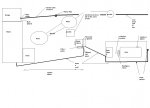The only connection to bonding for the water in my vinyl pool is through the stairs (some rust) and the impeller screw in the pump (disintegrating/rusting)..there is no light in our pool, and the only other metal anywhere is the aluminum coping which doesn't contact the water at all.. fiberglass stairs.. nothing else metal in this pool. Yes, we're on a well, and our neighbors are as well, but we're pretty rural (on a 4 acre lot). Our well is over 370 feet away, and our nearest neighbors well is even further. There is an overhead power line that supplies our house that passes nearby the pool, but all within tolerances for distances.
4 Months and Three Pump Replacements/Ladder Corrosion !! ..
- Thread starter gotee
- Start date
You are using an out of date browser. It may not display this or other websites correctly.
You should upgrade or use an alternative browser.
You should upgrade or use an alternative browser.
Well pumps are a common problem causing odd electrical currents. Rural areas are also more prone to such problems due to less frequent grounding of the service lines.
Phone lines can be another overlooked source of current.
Unless you have a poly pool, your pool walls and the rebar in the deck should all be connected to the bonding system.
I think it almost has to be electrical, as the chemistry would have to be insanely bad to even notice any corrosion, much less have the kind of rapid failure you are having.
Phone lines can be another overlooked source of current.
Unless you have a poly pool, your pool walls and the rebar in the deck should all be connected to the bonding system.
I think it almost has to be electrical, as the chemistry would have to be insanely bad to even notice any corrosion, much less have the kind of rapid failure you are having.
Sorry, yes the walls are poly with a vinyl liner-not steel or aluminum. The concrete decking is fully bonded with the coping/ladder/handrail/fencing/pump. Dominion came out and installed new ground rods at our service pole back at the house (I forgot to mention that we put the pool over 350 feet from the house) and this service pole is approximately 300 feet from any bonding for the pool.
gotee said:Sorry, yes the walls are poly with a vinyl liner-not steel or aluminum. The concrete decking is fully bonded with the coping/ladder/handrail/fencing/pump. Dominion came out and installed new ground rods at our service pole back at the house (I forgot to mention that we put the pool over 350 feet from the house) and this service pole is approximately 300 feet from any bonding for the pool.
Your electrical ground rod is 300ft from the bonding system, so you could be seeing a substantial current in your ground wire. Hopefully your electrician can figure it out.
Sigh, Electrician says that the current leakage is through the pump. He suspects that he may have wired the two speed setup for the Pool Pilot Digital improperly. All I know is it ran fine, albeit the motor ran extremely hot. He's going to be back tomorrow morning, but for now.. pool is off limits =-(
Well, that's a heck of a lot better than him saying "everything looks fine to me..."
Melt In The Sun said:Well, that's a heck of a lot better than him saying "everything looks fine to me..."
I agree. Sometimes finding these things is part voodoo, part crystal ball reading, so if he finds it in two trips, consider yourself lucky.
Actually, no it's a tan liner with the brick waterline. One more question though. Previously it was mentioned that the bonding and grounding for the pool should be totally seperate in the U.S., yet we noticed tonight that the Pool Pilot Digital has the bonding lug and the ground lugs on the exact same stainless steel backplate internally. This totally defeats that purpose. Does this mean that the bonding lug should be bypassed, or that the grounds should just be hooked together and the lugs not used? Is this something that Pool Pilot needs to know about?
Not to throw mud in the water (pun intended) but the NEC article 680.26(B) actually states "....shall not be required to be extended or attached to remote panelboards, service equipment, or electrodes." It does not prohibit connecting the bonding grid to the ground grid it's just not required (in the U.S.). It's hard enough to get people to understand that bonding and grounding are separate items so it confuses the issue by trying to say they can be tied together so we always say they're separate.
gotee said:Actually, no it's a tan liner with the brick waterline. One more question though. Previously it was mentioned that the bonding and grounding for the pool should be totally seperate in the U.S., yet we noticed tonight that the Pool Pilot Digital has the bonding lug and the ground lugs on the exact same stainless steel backplate internally. This totally defeats that purpose. Does this mean that the bonding lug should be bypassed, or that the grounds should just be hooked together and the lugs not used? Is this something that Pool Pilot needs to know about?
It's fine. It's normal for them to connect at the pump housing unless it's a double-insulated pump. In the US, you can connect the bonding system to the ground, but it is not required. In Canada, the bonding system must be connected to a ground. From reading the discussions prior to the 2005 NEC, it seems that the Canadian code provides more safety from lightning, while the US code provides more safety from an electrical accident like a backhoe next door hitting a power line. (an actual incident that inspired much of the bonding requirements)
In some countries the bonding and grounding systems are required to be connected. In the US the code used to say not to connect them intentional but that unintentional connections will occur anyway. Now it says that they don't have to be connected. There is almost always a connection between ground and bond inside the pump, and there is required to be a connection in the junction box of any 120v underwater light. Some other pieces of equipment will have connections in them as well, such as heaters and SWGs.
Hum, typing at the same time, so much duplication.
Hum, typing at the same time, so much duplication.
Thanks guys, such a wealth of information. Electrical code is greek to me. I think I'll stick to IT and gardening and let the electrician do his job =-D
Ok... electrician came out.. tested bonding grids and grounds as well as neutrals and all panels.. spent quite a bit of time on this. He DID find an issue with a GFCI circuit breaker he installed for the pump/SWG (Pool Pilot Digital). the neutral wasn't connected to anything, so it wasn't protecting us =-O He fixed that on the spot. But there is transient voltage in the ground system. He turned everything off and checked the flow throught the ground installed out at the pool pump house (this is a new ground rod installed when we installed the sub panel for the pool house/equipment and is over 300 feet from the house) there is like .12 millivolts at that connection. Thats it. he says that is coming from the house or from transient voltage in the ground. He also pointed out that our house (even though being only 5 yrs. old only has one ground rod with sandy loam soil. He says sandy loam is a poor conductor as it is and only one ground rod isn't enough for the house. He pointed out that since we went WAY overboard with the bonding and grounding at the pool area/pump house, and that the sub feed is grounded to the house as well, the house is using the pool area as a supplemental ground. Made sense. So he suggests we add two more extra long ground rods at the house and install the sacrificial anode in the water line for the pool as you can never get rid of ALL transient voltage.
bk406
0
Did he say if the subpanel needed that grounding rod? Normally, thats not done. If the subpanel is connected to the main, the only ground is at the main, not the sub.
Another thing to check is to make sure the subpanel has the bonding strip removed from between the ground and neutral bus inside the panel. Only the main should have the neutral and ground connected.
Another thing to check is to make sure the subpanel has the bonding strip removed from between the ground and neutral bus inside the panel. Only the main should have the neutral and ground connected.
Called him and asked about the ground at the pool/pump house. He says that the ground is required at the sub panel since it's located in another structure and over 300 feet from the main. Also he says the bonding between the neutral and ground is removed at the sub.
bk406
0
Ok, i had missed the part where your subpanel was 300 feet away. Thats a pretty good distance.
0.12 millivolts is minimal, very common, nothing to worry about, and nowhere near enough to cause the problems you are having.
The problems you describe require something like a direct 120 volt short to the water, which is constantly running current through the water to the bonding system. Nearly any hot wire to water short ought to also be directly shorted to the bonding system and from there to ground, which would blow a circuit breaker, and would not run current through the water. Getting large currents through the water to happen is rather tricky, requiring multiple unlikely wiring mistakes. Which makes the whole thing very mysterious.
The problems you describe require something like a direct 120 volt short to the water, which is constantly running current through the water to the bonding system. Nearly any hot wire to water short ought to also be directly shorted to the bonding system and from there to ground, which would blow a circuit breaker, and would not run current through the water. Getting large currents through the water to happen is rather tricky, requiring multiple unlikely wiring mistakes. Which makes the whole thing very mysterious.
Thread Status
Hello , This thread has been inactive for over 60 days. New postings here are unlikely to be seen or responded to by other members. For better visibility, consider Starting A New Thread.



